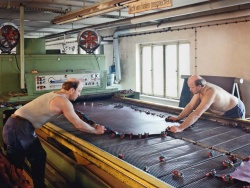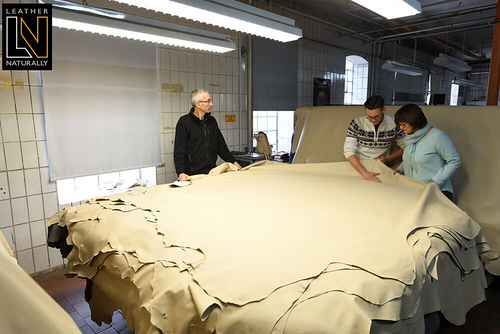Difference between revisions of "Leather production"
| Line 124: | Line 124: | ||
== [[Drying leather|Withering - Samming]] == | == [[Drying leather|Withering - Samming]] == | ||
| − | [[Wastewater from tanneries|Residual water]] from wet skins is pressed out by forcing it through metal rolls. There are various methods to dry the leather in the intermediate steps of the leather production in the [[tannery]]. Depending on the requirements, the [[Leather production#Splitting|splitting of the leather]] can only be carried out after the samming process. | + | [[Wastewater from tanneries|Residual water]] from wet skins is pressed out by forcing it through metal rolls. The leather must not be pressed too hard when samming, in order to avoid damage to the [[leather grain|grain]]. There are various methods to dry the leather in the intermediate steps of the leather production in the [[tannery]]. Depending on the requirements, the [[Leather production#Splitting|splitting of the leather]] can only be carried out after the samming process. |
Revision as of 16:21, 13 July 2023
The leather production process is lengthy and involves several steps which have to be carried out before the actual tanning is done. The most important stages in converting the raw animal hide to leather are listed below. According to a tanner, furniture leather undergoes between 35 to 55 different processes, depending on the desired leather type. Each step is very important and regular checks need to be carried out to ensure the best quality of leather is produced.
Contents
- 1 Preservation by drying, salting or freezing
- 2 Beamhouse Operations
- 3 Soaking
- 4 Liming
- 5 Fleshing
- 6 Splitting
- 7 Pickling
- 8 Tanning
- 9 Neutralising
- 10 Withering - Samming
- 11 Sorting
- 12 Shaving
- 13 Dyeing - Fatliquoring - Re-tanning
- 14 Drying
- 15 Softening
- 16 Finish - Surface colouration and surface processing
- 17 Final check
- 18 Videos about the leather production
- 19 Additional information
Preservation by drying, salting or freezing
Rawhides have to be conserved after the animals have been slaughtered and before they reach the tannery. In some cases, they can be stored for a while. These rawhides are checked for quality and also sorted by weight before arriving at the tannery.
Additional information to this processing step
Beamhouse Operations
The process of preparing the hides for tanning is known as beamhouse operations (wet production). This involves all stages mentioned below between preservation and tanning.
All skins and hides which are completed as finished products, without undergoing any tanning, retain the characteristics of untanned skin including parchment. One common by-product derived from rawhide is dog chews.
Soaking
The hides are soaked in clean water to get rid of any dirt and mainly to remove the salt applied in the earlier stage. Curing (salt conservation treatment) also removes water from the hides and soaking them makes the hides swell and return to their original softness. The hides can be treated for several days, depending on the amount of salt and the dryness of the skins. Salted bovine hides need several hours and dried hides need several days.
Additional information to this processing step
Liming
One of the most important steps in beamhouse operations is ‘liming’. The hides are soaked in liming drums which contain a solution made of lime and sulphur compounds. The main purpose of this process is to separate the hair from the hides. The net result is hairless hides which are very greasy, mainly because they still have a high fat content.
After liming the hide is hairless.
Additional information to this processing step
Fleshing
By this stage, the hides are still in a soaked yet softened condition. Traditionally, using a sharp but curved blade, any excess flesh was removed by placing them on a beam. However, this process is now done by machine. Any debris that is left over is referred to as ‘glue stock’.
Additional information to this processing step
Splitting
To get a uniform thickness, the hide/skin is cut into two or more horizontal layers. The top layer, or grain side will produce a fine, smooth grain leather. The bottom is used for suede or split leather for other uses.
Additional information to this processing step
Pickling
The Pickling process makes the fibres of the hides and skins more receptive to tanning.
Additional information to this processing step
Tanning
In the tanning process tannins are absorbed by the hides and skins and turn them into leather. By tanning the skin is irreversibly chemically preserved and converted to the material leather.
Additional information to this processing step
Neutralising
Leftover acids from the tanning are neutralised.
Additional information to this processing step
Withering - Samming
Residual water from wet skins is pressed out by forcing it through metal rolls. The leather must not be pressed too hard when samming, in order to avoid damage to the grain. There are various methods to dry the leather in the intermediate steps of the leather production in the tannery. Depending on the requirements, the splitting of the leather can only be carried out after the samming process.
Water from wet leather is drained by squeezing.
Additional information to this processing step
Sorting
The leather then undergoes a quality check and is sorted according to the quality. Hides which do not have any blemishes or marks are best quality and can be processed to aniline leather. The ones which have marks may be processed into corrected grain.
Aniline leather must be flawless. Even the smallest damages in the main surface are sorted out.
Shaving
In the shaving process the leather is thinned and equalized using a leather shaving machine which cuts off leather fibres from the flesh side.
Additional information to this processing step
Dyeing - Fatliquoring - Re-tanning
Depending on the type of leather, the leathers are coloured using aniline dyes (through coloring by drum dyeing), the softness of the leather is controlled by fatliquoring (regreasing) and the retanning improved the desired properties of the leather.
Drying
For the drying of leather in the individual steps in the tannery there are many different methods. Vacuum drying and suspended drying in ovens are the most common.
Vacuum drying - Suspended drying - Stretching and drying frame in ovens
Additional information to this processing step
Softening
After drying, the leather is further softened on different machines (tumbling, stacking).
Tumbling - Stacking machine
Additional information to this processing step
Finish - Surface colouration and surface processing
Depending on the required specifications, the surface of the leather has to be treated further. Pigmentation, pressing, ironing, embossing, adjusting of gloss level etc.
Additional information to this processing step
- Finish - Surface colouration and surface processing
- Leather colour
- Ironing leather
- Embossing leather
Final check
Final re-check of product quality according to the specifications of the type of leather and/or the customer and size measurement of the skins are carried out. Then the leather is stored or packed and sent to the customer.
Final inspection (photo by LEATHER NATURALLY) and size measurement of the skin area.
Videos about the leather production
The leather production in a modern tannery.
The brain tanning process.
The leather production with tannins from oak.
Chamois leather production in Germany.
Additional information
| Process steps in the leather production |
|---|
| Storage - soaking - liming - fleshing - splitting - pickling - tanning - neutralising - withering - sorting - shaving - dyeing - fatliquoring - retanning - drying - finish - softening - final check |
| Tanning methods |
|---|
| Chrome tanning - Vegetable-tanned leather - Synthetic tanning - Tanning with fats and oils |



































 a kotori web solution
a kotori web solution